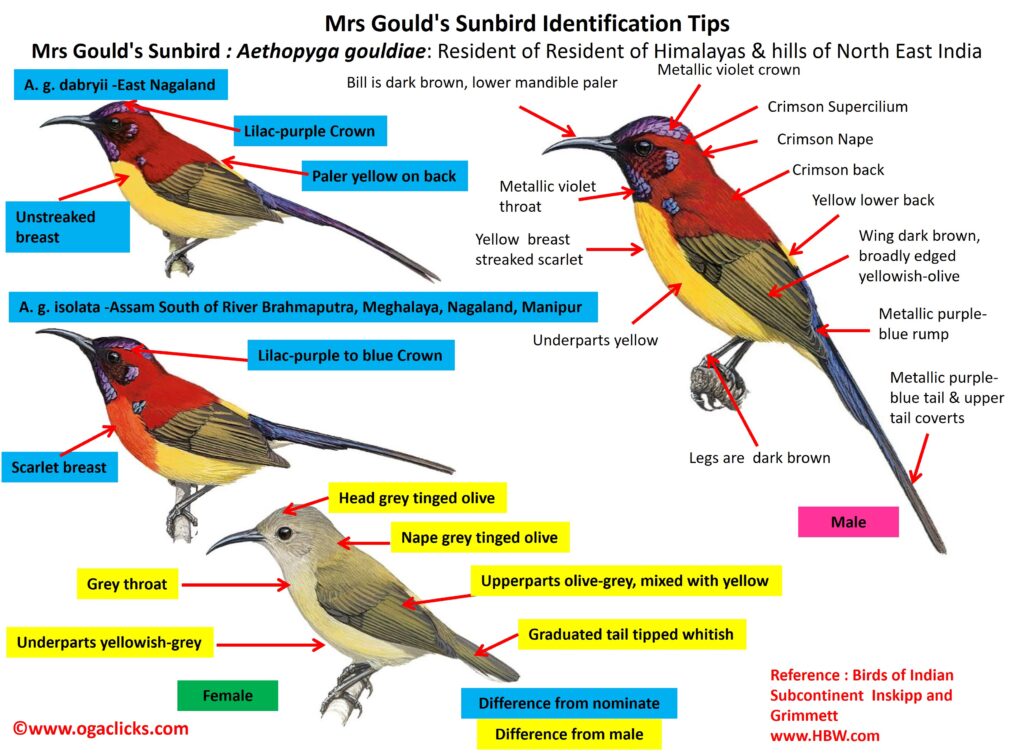
Mrs Gould’s Sunbird Aethopyga gouldiae
Etymology:
- Aethopyga : Greek word aithos – fire, burning heat; puge– rump
- Gouldiae : Named after Elizabeth Gould (1804–1841), wife of English publisher and naturalist John Gould (1804–1881)
Distribution :
- Nominate- Himalayas from North India (Sutlej Valley East to Arunachal Pradesh)
- g. isolata–North East India (Assam South of River Brahmaputra, Meghalaya, Nagaland, Manipur)
Subspecies :
- Nominate- Himalayas from North India (Sutlej Valley East to Arunachal Pradesh)
- g. isolata–North East India (Assam South of River Brahmaputra, Meghalaya, Nagaland, Manipur){Male has paler yellow on back and breast than nominate, generally purple (not purple-blue) gloss, and central rectrices more violet-blue}
Description: Size of male 14–15 cm, wt. of 6·5–8 g; Size of female 10 cm, wt. of 6·1 g. It is a short-billed sunbird. The male is long tailed. The male of nominate race has metallic violet crown, ear-coverts, throat and patch on side of neck. It has a crimson supercilium, side of head, neck, nape and back. It has bright yellow lower back, metallic purple-blue rump, uppertail-coverts, and tail. The lesser and median upperwing-coverts are like upperparts, remainder of wing dark brown, broadly edged yellowish-olive on greater upperwing-coverts, tertials and secondaries, more narrowly on primaries. The central tail feathers are very long, outer feathers tipped buff. The underparts are yellow, usually streaked scarlet on breast, more olive on vent. The iris is dark brown, reddish-brown or crimson; bill dark brown, lower mandible paler, or all blackish; legs dark brown, soles are paler. The female has head and nape as grey tinged olive, upperparts olive. The rump is yellow or yellowish; graduated tail tipped whitish. The throat is pale grey, underparts are yellow or yellowish grey. The juvenile is like female, but greener above, brighter yellow below, tail less graduated and with tips less white, pale lower mandible. The subadult male is like female, but has patches of red above, blue rump, longish metallic tail, grey throat and brighter yellow below. Race isolata male has paler yellow on back and breast than nominate, generally purple (not purple blue) gloss, and central rectrices more violet blue.
Habitat: It is found in forest types, like oak forest, ridgetop forest and conifers, scrub-jungle. It is found from 1200 m –4270 m when breeding and comes down to 330 m–2700 m in winter.
Food habits: It eats nectar, spiders and insects. It forages at all levels, typically among lower branches and undergrowth, often at mistletoes and rhododendrons.
Breeding habits: They breed from Apr–Aug in India. The nest pear-shaped or oval, the entrance is reinforced rim about two-thirds way up, made from vegetable down, fibrous material, green moss, grass shreds and cobweb, lined with soft cotton down, and suspended from fern or twig low in bush or bramble . They lay a clutch of 2-3 eggs. The nest is parasitized by Asian Emerald Cuckoo.